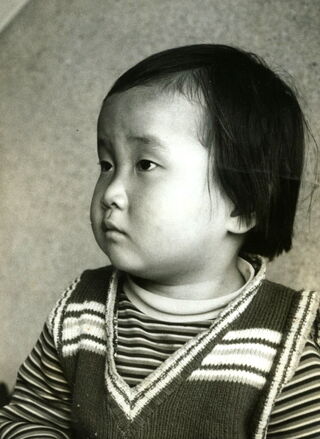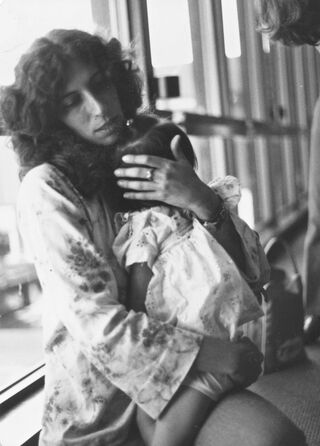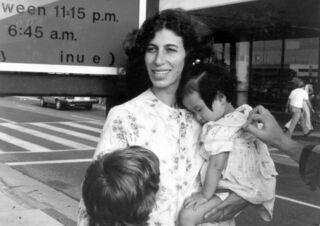Adoption
Adoption Diary, Part I: Giving Birth in an Airport
Who knew that parents could give birth to a 3-year old child?
Posted August 27, 2012

Thirty-five years ago, my husband, young son, and I flew from Sacramento to Los Angeles to meet a Northwest Airline flight coming from Korea, carrying a little girl who was to become our second child. It was 1977. I’d given birth to our son, Jamal, in April of 1970. Now, he was going to have a sister.
She was about three years old. We chose the name Mara for her. We didn’t know her birth name, nor did we know the date of her birth. She was dropped off at a police station in Seoul and was given the name Nam Hee which, we were told, referred to the geographic location of the station.
Three months before she arrived, a woman from the adoption agency that my husband and I had been working with called and said she had a child who was available. We were asked to come and look at a picture of her. On the left is the picture we were shown. The adoption worker said, “Do you want this child?” I don’t remember our exact response, but it was along the lines of “Yes! Yes! Yes!” It took three months from the time of that meeting for all the paperwork to be completed. Until then, all we had was this picture. We were fortunate that Mara was put in a foster home in Seoul, rather than having to spend those three months in an orphanage. We think she became very attached to the woman who cared for her in the foster home, making me her third mother in as many years.
Our friends Nathan and Ginny, who live in Los Angeles, met us at the airport and took pictures as the day unfolded. The plane was about an hour late. The wait was difficult; we were nervous and excited. But finally, we saw the Northwest flight pull up to the gate. Four or five flight attendants came off the plane, each carrying a child. Based on the picture we had, we approached one of the children. But just at that moment, we heard someone call out “Bernhard!”
We turned and there was a petite little girl, in a white lacey party dress and bright red shoes. She was in the arms of a flight attendant who was reading our name off a clear plastic band on her tiny wrist. I went over and he transferred her into my arms. I remember that moment vividly. It was like giving birth to my second child.

Mara was as light as a feather and completely limp in my arms. I took it as acceptance of me, but I know now that she was just groggy from being carried off the plane without being fully awake. She stayed limp in my arms for about twenty minutes—long enough for us to take the shuttle bus from the international terminal back to the Southwest Airline terminal where we were to catch a flight back to Sacramento.

When we reached the terminal, Mara woke up, drank some apple juice, took a bite of a rice cracker, smiled briefly at her new brother’s playful antics (so he got the first smile out of her), and then threw her head back and began to wail. Through her sobs, she was screaming, “Umma, umma,” which means mother. (The adoption agency in Korea had sent us a small pamphlet that included translations of a few Korean words into English.)
We think that she was crying for her foster mother, but it could have been for her birth mother. Given the plain clothing worn by the other children who were carried off the plane, we do feel certain of one thing: her foster mother put her in that fancy dress and shoes to assure that we’d fall in love with her at first sight.
Our return flight wasn’t for hours because we’d wanted to be sure we left extra time in case the flight from Korea was delayed. So there we were in the waiting room with a child crying and screaming “umma” inconsolably. The woman at the ticket counter took pity on us (and the other people in the waiting room) by moving us into first place on standby for an earlier flight. We got on it, but I could see the distress on the other passengers’ faces as Mara wailed all the way to our seats. Luckily, when the flight attendant brought some water, she drank it and then fell asleep for the hour and a half flight.
We arrived home as a family of four.
In the days that followed, Mara was always cheerful during the day, but once nighttime fell, the wailing would start—three to four hours of deep wailing like I’ve never heard before or since. Interspersed with her anguished sobs were calls for “umma.”
See Part II: A New Life…and Clues to a Former Life and Part III: My Daughter in Her Own Words.
© 2012 Toni Bernhard. Thank you for reading my work. I'm the author of four books:
How to Be Sick: Your Pocket Companion (for those who've read How to Be Sick and for those who haven't) May 2020
How to Live Well with Chronic Pain and Illness: A Mindful Guide (2015)
How to Wake Up: A Buddhist-Inspired Guide to Navigating Joy and Sorrow (2013)
All of my books are available in audio format from Amazon, audible.com, and iTunes.
Visit www.tonibernhard.com for more information and buying options.
Using the envelope icon, you can email this piece to others. I’m active on Facebook, Pinterest, and Twitter.
Image credits: Top photo by permission of Korean Social Welfare Agency. Other photos by permission of my husband, Tony Bernhard




